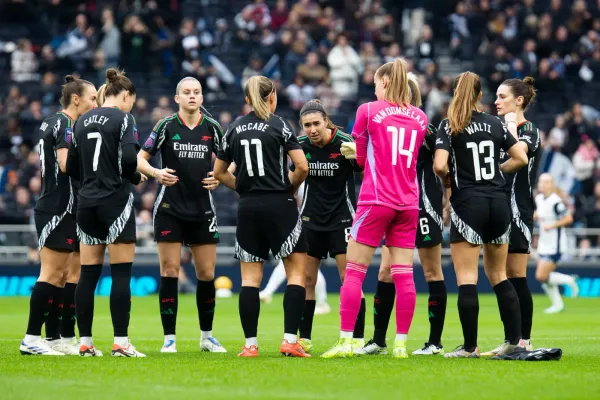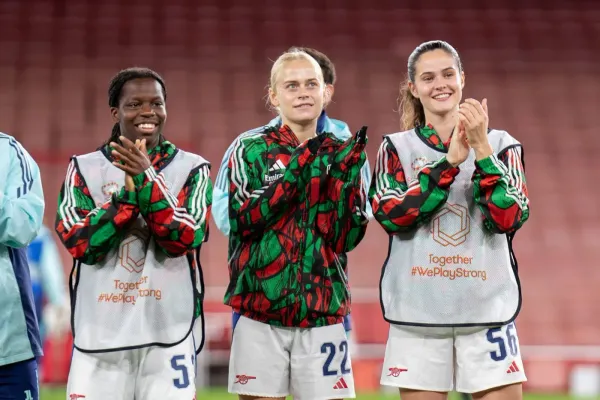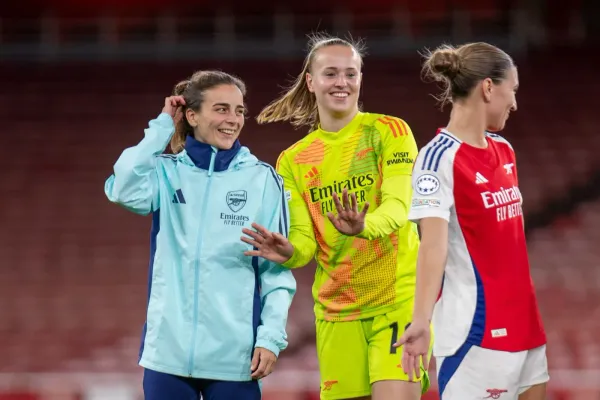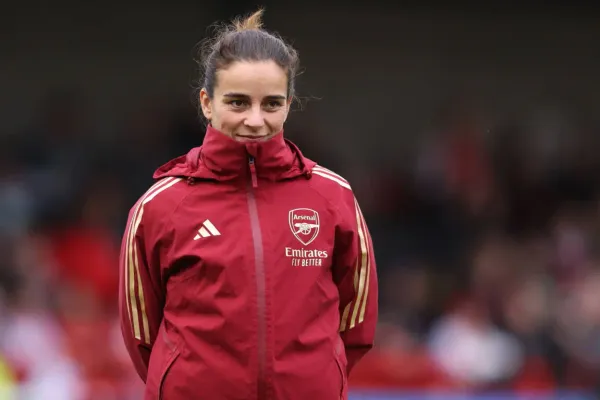Repurposing Russo
Eidevall looking to slightly alter Russo’s general will
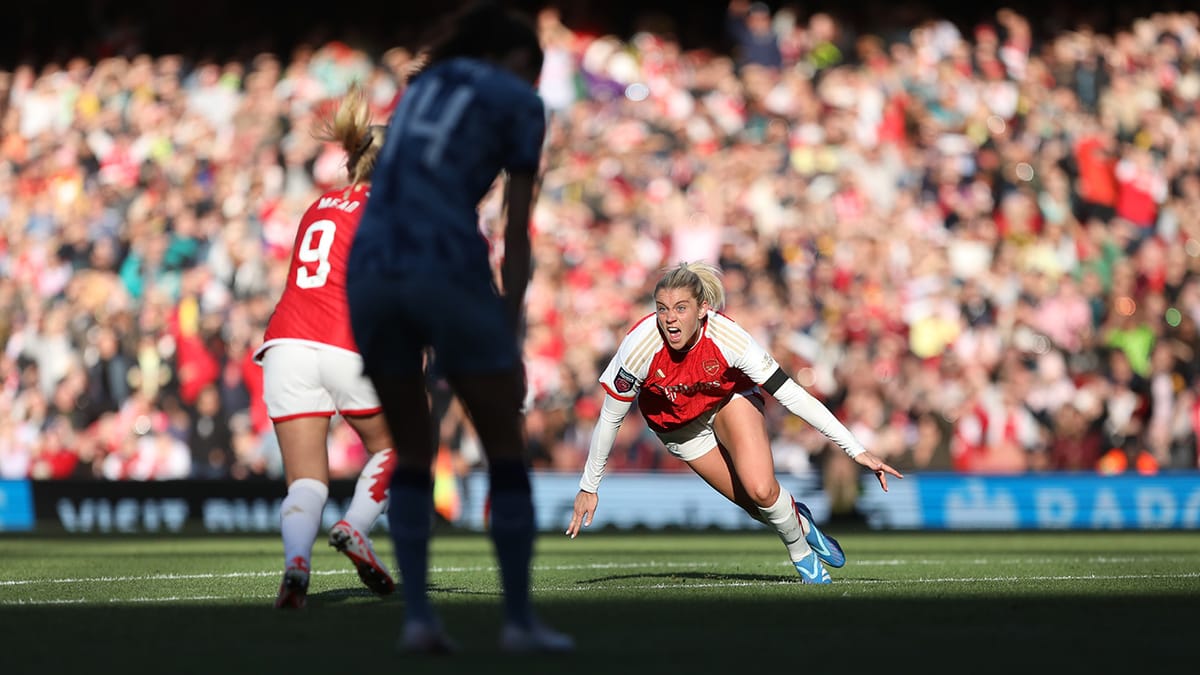
I spoke to Vivianne Miedema in September 2021, shortly after Jonas Eidevall took charge of Arsenal. At this point, the Gunners had beaten Chelsea 3-2 on the opening game of the season and were about to thump Manchester City 5-0 at Meadow Park as opponents were not adjusted to the team’s altered, more direct style of play under Jonas Eidevall.
I asked Miedema, who spent her youth career as a number 10 before being repurposed as a 9 due to a shortage in the position at international level, about the change in her role. ‘There is more of an emphasis on winning the ball back, whereas over the last couple of years with Joe the emphasis was on having the ball. I know I need to be in the box a bit more now!’
Under Joe Montemurro, Miedema operated slightly more like a false 9, moving deep to connect play and allowing Arsenal’s relay of attacking midfielders like Jordan Nobbs, Danielle van de Donk and Kim Little to run into the space behind her. The strategy made very easy work of the WSL’s deep block defences. Arsenal went two and a half years without dropping a single point against the teams placed 5th to 12th in the division.
However, that Total Football style came a cropper against Manchester City and Chelsea and, latterly, Manchester United too. Jonas Eidevall was appointed with far more of an emphasis on being direct, winning the ball high up the pitch and retaining structure off the ball so that his team were not vulnerable to being counter-attacked.
He plays with a midfield double pivot who ordinarily do not venture too far forwards. For this to work, Eidevall wants a striker who retains a high position in the penalty area, both to press centre halves and to make sure they are in a position to take advantage when Arsenal do win the ball high up the pitch. (And now, to all intents and purposes, Arsenal have totally reversed their Joe Montemurro experience as they relish the bigger games and struggle against deep block defences).
Later that winter, I noticed a pattern where Miedema, previously a ‘95 minutes every single game no matter what’ type of player, was being substituted very regularly. I asked Eidevall about it and he explained that his pressing game was very demanding on the centre forward.
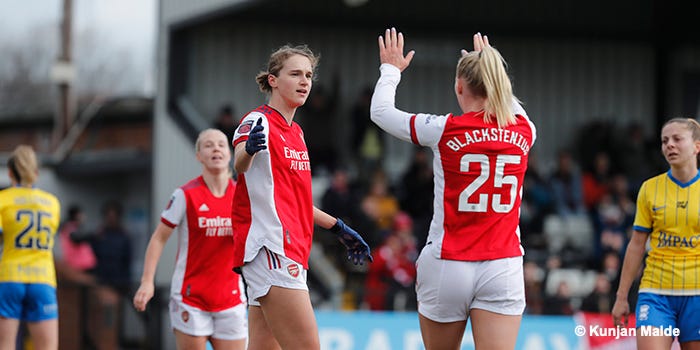
‘The way we want to press from the front is very demanding, especially for the centre-forward. In most teams, the centre-forward is the most commonly substituted player because it is so physically demanding. But it is about getting that balance right too because every player likes to play the full 90 minutes so we have to be a little aware of that too. I cannot get into the habit of only playing a player for 60 or 70 minutes all the time either.’
I just wasn’t entirely satisfied by the suggestion this was purely about loading and pressing, I increasingly got the impression that Miedema just wasn’t the type of striker Eidevall wanted for his football. That January, he bought Stina Blackstenius, one of the most obvious proponents of ‘running the channels and filling the penalty area’ centre-forward play in Europe and he pushed Miedema behind her into a deeper role.
Last summer, of course, Arsenal signed Alessia Russo from Manchester United and, at the time, I wrote a lengthy analysis piece on why she had all the ingredients to be the ideal striker for Jonas Eidevall’s system. However, it has become clear during this season, particularly as Arsenal have struggled with deep block defences, that Russo has required some readjustment time.
In his pre Manchester United press conference, I spoke with Eidevall at length about Russo’s undoubted qualities coming deep and connecting play and balancing those with her getting into the penalty area more often. I had been really struck by an unprompted comment he made to me about her headed goal against London City Lionesses in the Conti Cup last week.
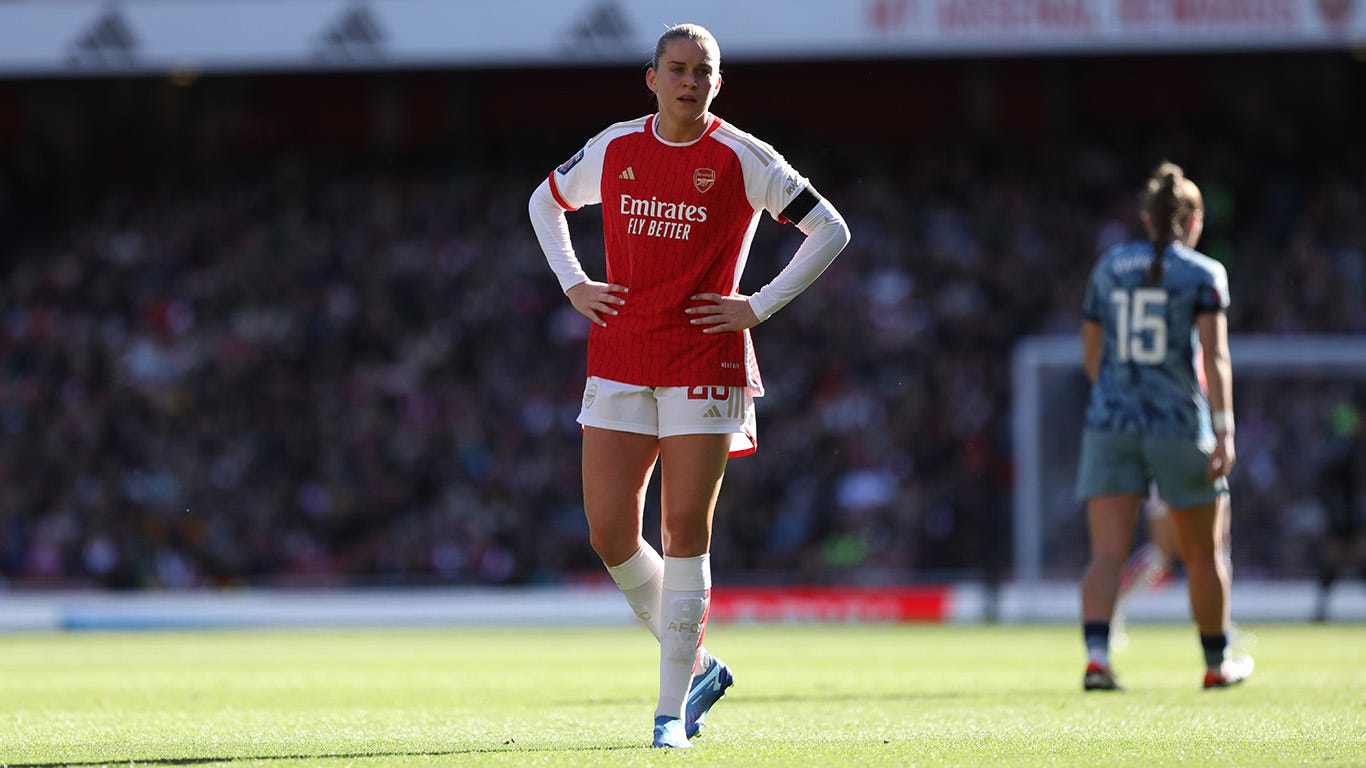
‘We create a really good crossing situation and Lessi is great in that whole attack and has sixty seconds of perfect positioning as a 9. She only touches the ball once and that’s when she scores.’ In 2022-23, half of her goals for club and country were headers. With Ona Batlle and Lucy Bronze providing the bullets from full-back, Russo was an outstanding weapon in the penalty area and it’s clear Eidevall wants to juice more of that attribute from the player.
In our conversation, Eidevall suggested that he and Kelly Smith were working with Russo so that she drops deep less (not never) and stays in the penalty area more often. ‘What people generally do to help the team is to show for the ball but what you need in football, especially in the 9 position, is to create space for yourself and the team.
‘One of the best things to do to create space is to go away from where the ball is because it is really hard for the defender to see you and the ball at the same time and those are your two biggest cues as a defender.’ Russo was a star signing for Arsenal, a transfer that generated a level of interest I have never witnessed before for Arsenal Women.
But some people did question whether Russo, with 10 WSL goals last season for United, was going to be prolific enough for an Arsenal team competing with City and Bunny Shaw and Chelsea and Sam Kerr. What is becoming clearer to me over time is that Eidevall thinks he can ever so slightly repurpose Russo into that Golden Boot contending striker.
Earlier in the campaign, he described her as ‘the best finisher I have ever worked with.’ Given that Jonas currently works with Vivianne Miedema it is a big claim and I always felt it was one designed to imbue Russo with confidence. I think he is essentially trying to provoke Russo’s more ‘selfish’ instincts. Because she is an absolute team player, maybe even to a fault at times.
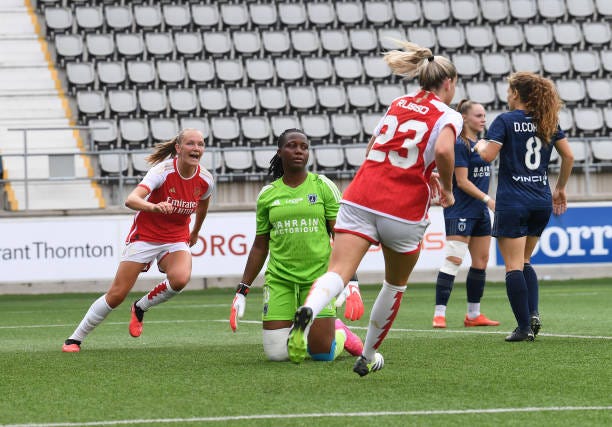
Whereas Eidevall seemed to consider he probably couldn’t mould Miedema into being the perfect ‘Eideball’ striker, I think he believes Russo has the overall attributes to do that but, despite the fact she is England’s starting number 9 (more often than not) I increasingly view this as a slight development project. It’s been an adjustment at international level too because England moved from the ultimate penalty box striker in Ellen White, to Russo.
At club and international level, Russo formed a lethal partnership with Ella Toone who, incidentally, has not looked the same player at all without Russo to play off at club level. Toone would run in behind to the space Russo often vacated but none of Arsenal’s 10s are really asked to do that in the same way.
It is telling that Stina Blackstenius was preferred through the middle for both games against Manchester United- a team who leave a lot of space in behind. Eidevall felt Stina was better placed to attack the penalty area and pin the centre-backs when Arsenal got in behind.
Blackstenius has started three WSL games this season and Russo has started all but one (she started behind Stina away at Brighton and on the left wing in the United away match). Stina came on as a sub and scored the winner in the WSL game at home to City as Arsenal fell into a deep block and sought to counter. So Blackstenius is a horse for a very particular type of course.
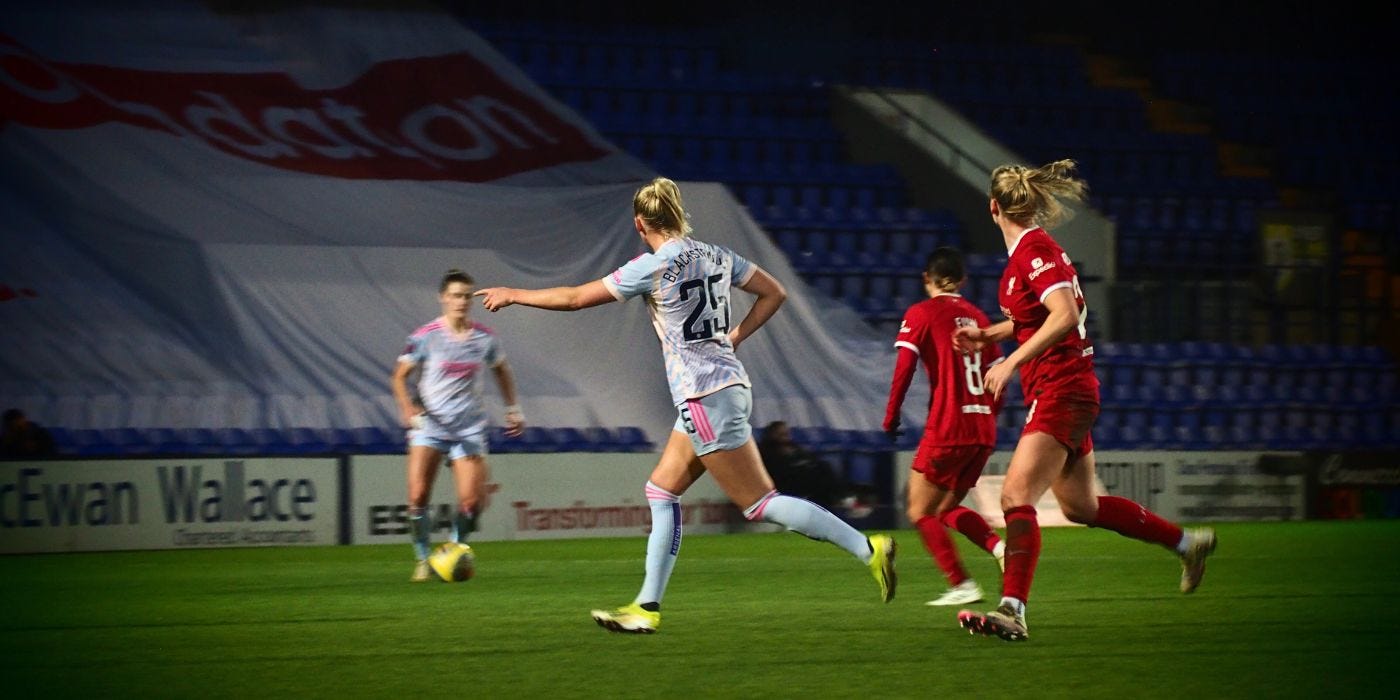
The aim for Russo is to become the sort of striker that leaves no food on the plate for her Swedish competitor and develops those penalty area instincts. I think Eidevall made some really interesting comments about Russo in October which, inadvertently, described his other striking options too.
‘Sometimes you have a forward that is really hard working, really loyal, works extremely hard in defence and you can live with that player not being so good technically, for example, or not being a great finisher. Then sometimes you have a player that is a great finisher, but you don’t get exactly 100 per cent in defence and maybe you can live with that for the team as well because of what it can provide with you in offence.
‘Sometimes that player is really good technically when there is not a player around her, so it’s not any duels, but once it’s a duel, that player starts to lose the ball, but you can live with that because the moment that she isn’t in a duel, they provide so much for the team.
‘But now you see Alessia has qualities and she can work hard in defence, she’s clever in defence, but she can also score goals. She’s an excellent finisher both with her head and with her feet. She’s a technical player, but she can also control the duels and be really physical and protect the ball.” It’s utilising Russo’s finishing skills that Eidevall wants to fine tune and that is simply a case of her spending more time in the positions where she can use them.

